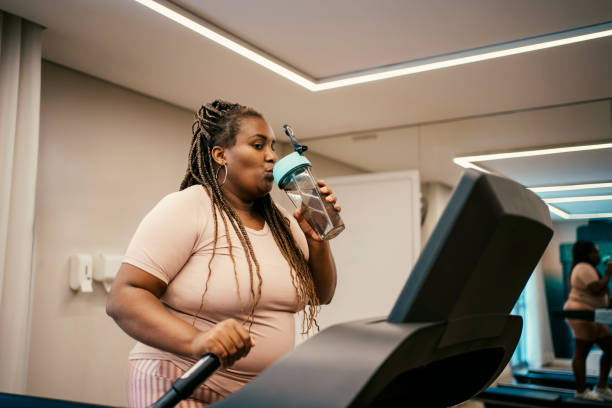(BlackFitness101.com) In the realm of health and fitness, setting goals is an essential part of the journey. Whether you’re just starting out or have been working out for years, having specific, measurable, and achievable goals can significantly impact your success. However, one of the most common mistakes people make is setting unrealistic goals, leading to frustration, burnout, or even injury. As a fitness trainer with years of experience, I’ve seen firsthand the importance of setting realistic fitness goals and the incredible progress that can be made when those goals are properly structured and pursued. In this article, we will delve into how to set realistic fitness goals and, more importantly, how to achieve them.

Why Setting Fitness Goals is Important
Before we jump into the “how,” let’s talk about the “why.” Setting fitness goals is crucial for several reasons:
- Motivation: Goals give you something to strive for. They provide a clear path and purpose, which can be incredibly motivating. Knowing what you’re working towards keeps you committed, especially on days when you might not feel like working out.
- Measurable Progress: Goals allow you to measure your progress. Whether you’re looking to lose weight, build muscle, or improve endurance, having a goal lets you track how far you’ve come. This progress measurement can be incredibly rewarding and can encourage you to keep going.
- Focus: With clear goals, you can tailor your workout and nutrition plans to meet specific objectives. This focus prevents you from engaging in random exercises that don’t contribute to your end goals, making your efforts more efficient.
- Accountability: Goals hold you accountable. When you set a goal, especially if you share it with others or write it down, you create a level of accountability that pushes you to stick with your plan.
Understanding the SMART Framework
To set realistic fitness goals, it’s helpful to follow the SMART framework. SMART stands for Specific, Measurable, Achievable, Relevant, and Time-bound. Let’s break down each component and how it applies to fitness.
1. Specific
A specific goal has a much greater chance of being accomplished than a general one. To set a specific goal, ask yourself:
- What exactly do I want to accomplish?
- Why is this goal important to me?
- What resources or knowledge do I need to achieve this goal?
For example, instead of saying, “I want to get fit,” a specific goal would be, “I want to run a 5K in under 30 minutes within the next three months.”
2. Measurable
A measurable goal allows you to track your progress and stay motivated. It answers the questions:
- How much?
- How many?
- How will I know when it’s accomplished?
If your goal is to lose weight, determine how many pounds you want to lose. If your goal is to build muscle, decide how much muscle mass you want to gain or what weights you want to lift by the end of your training period.
3. Achievable
Your goal should be challenging yet attainable. It should stretch your abilities but still remain possible. Ask yourself:
- How can I accomplish this goal?
- Are there constraints I need to consider?
For instance, if you’ve never run before, setting a goal to complete a marathon in a month may not be achievable. However, aiming to run a 5K in three months is more realistic.
4. Relevant
Your goal should matter to you and align with other relevant goals. It should answer:
- Does this goal seem worthwhile?
- Is it the right time to pursue this goal?
- Does this goal align with my long-term objectives?
If your long-term objective is to improve your overall health, then a relevant short-term goal might be to reduce body fat percentage or improve cardiovascular endurance.
5. Time-bound
Every goal needs a deadline. A time-bound goal answers the question:
- When will I achieve this goal?
Setting a timeline creates a sense of urgency and prompts you to work towards your goal consistently. For example, “I want to lose 10 pounds in the next 10 weeks” is a time-bound goal.
Setting Realistic Fitness Goals
Now that you understand the importance of setting goals and how to structure them, it’s time to dive into setting realistic fitness goals.
1. Assess Your Starting Point
Before setting any goals, it’s essential to assess your current fitness level. Understanding where you are starting from will help you set realistic and achievable goals. You can do this by:
- Taking body measurements (e.g., weight, body fat percentage, muscle mass)
- Testing your current fitness levels (e.g., how far you can run, how many push-ups you can do)
- Understanding your dietary habits and how they impact your fitness
This assessment will give you a baseline from which to measure progress and ensure that your goals are appropriate for your starting point.
2. Set Short-Term and Long-Term Goals
When setting fitness goals, it’s essential to differentiate between short-term and long-term goals. Short-term goals act as stepping stones towards your larger, long-term objectives.
For example:
- Short-term goal: “I want to lose 2 pounds in the next two weeks.”
- Long-term goal: “I want to lose 20 pounds in the next six months.”
Short-term goals keep you motivated and focused, while long-term goals give you something substantial to work towards.
3. Be Honest About Your Time and Commitments
One of the biggest mistakes people make when setting fitness goals is not considering their lifestyle, time constraints, and other commitments. It’s crucial to be honest with yourself about how much time you can realistically dedicate to working out and eating healthy.
If you have a full-time job, a family, or other significant commitments, setting a goal to work out for two hours every day may not be realistic. Instead, consider how you can incorporate shorter, more intense workouts or find ways to be more active throughout the day.
4. Focus on Consistency Over Perfection
In the pursuit of fitness goals, consistency is more important than perfection. It’s better to work out three times a week consistently than to aim for six days a week and only make it once.
Set goals that prioritize regular, sustainable habits rather than extreme changes that are difficult to maintain. For instance, if you’re new to exercise, start with a goal to work out three times a week and gradually increase the frequency as you build your fitness level.
5. Adjust Your Goals as Needed
Life is unpredictable, and sometimes your goals need to be adjusted. Whether it’s due to injury, illness, or a change in circumstances, it’s important to be flexible with your goals.
If you find that your original goal is no longer feasible, adjust it rather than giving up entirely. For example, if you set a goal to run a 10K but sustained an injury, adjust your goal to focus on recovery and maintaining your fitness in other ways until you’re ready to run again.
Achieving Your Fitness Goals
Setting realistic goals is the first step; now, let’s talk about how to achieve them.
1. Create a Plan
Once you’ve set your goals, the next step is to create a plan to achieve them. This plan should include:
- A workout schedule: Determine how many days a week you will work out and what types of exercises you will do.
- A nutrition plan: Consider how your diet needs to change to support your goals. This might include meal prepping, counting macros, or making healthier food choices.
- Progress tracking: Decide how you will track your progress. This could be through regular weigh-ins, body measurements, or fitness tests.
A well-structured plan will help you stay on track and ensure that your efforts are aligned with your goals.
2. Stay Accountable
Accountability is key to achieving your fitness goals. There are several ways to stay accountable:
- Workout buddy: Find a friend or family member with similar goals and work out together. Having someone to share your journey with can be incredibly motivating.
- Personal trainer: Hiring a personal trainer provides professional guidance and accountability. A trainer can help you set realistic goals, create a tailored workout plan, and keep you on track.
- Track your progress: Keep a journal or use an app to track your workouts, meals, and progress. Seeing how far you’ve come can be a powerful motivator to keep going.
3. Celebrate Your Successes
Don’t forget to celebrate your successes along the way. Whether it’s reaching a short-term goal or making progress towards a long-term one, take time to acknowledge and reward yourself for your hard work.
Celebrating successes, no matter how small, keeps you motivated and reinforces the positive behavior that will lead you to your ultimate goals.
4. Stay Positive and Patient
Achieving fitness goals takes time, and it’s important to stay positive and patient throughout the process. There will be challenges, setbacks, and days when you don’t feel like you’re making progress. However, it’s essential to keep a positive mindset and remember that consistency and persistence will eventually lead to success.
Patience is especially important when it comes to fitness. Results don’t happen overnight, and it’s crucial to focus on the process rather than just the outcome. Trust that the small, consistent efforts you’re making each day will add up to significant progress over time.
5. Adapt and Overcome Challenges
No fitness journey is without its challenges. Whether it’s a busy schedule, lack of motivation, or physical limitations, it’s important to adapt and find ways to overcome these obstacles.
If you’re struggling with motivation, consider changing up your routine, trying new exercises, or setting new, smaller goals to keep things interesting. If time is an issue, look for ways to be more active throughout the day, such as taking the stairs instead of the elevator or doing a quick workout during your lunch break.
Remember that challenges are a normal part of the process, and overcoming them is what makes your fitness journey rewarding.
Setting and achieving realistic fitness goals is a journey that requires careful planning, commitment, and a positive mindset. By following the SMART framework, assessing your starting point, and creating a well-structured plan, you can set yourself up for success. Remember to stay consistent, celebrate your progress, and be patient with yourself along the way.
Fitness is not just about reaching a destination; it’s about enjoying the journey, learning about yourself, and developing habits that will support your health and well-being for life. Whether your goal is to lose weight, build muscle, or improve your overall fitness, the principles discussed in this article will guide you towards achieving your goals in a sustainable and rewarding way.
Staff Writer; Leroy Smith
Questions? Feel free to email me at; LSmith@BlackFitness101.com.












Leave a Reply